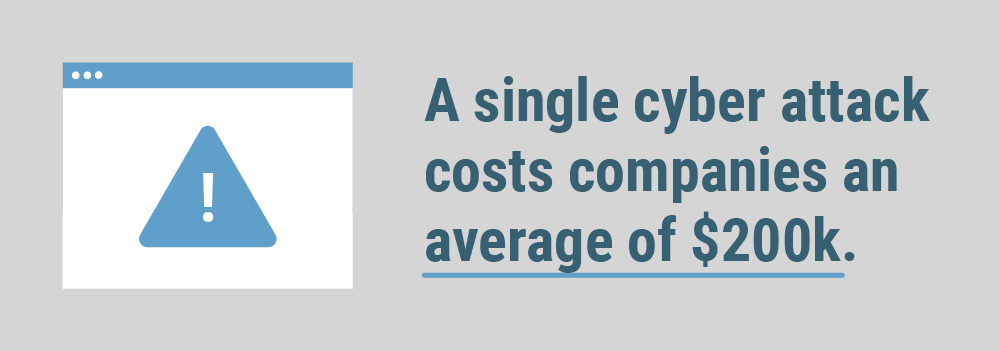Recent Uptick in Cybercrime Ups the Need for Cyber Liability Insurance
The increased role of technology has created more opportunities for criminals to commit cybercrimes that penalize businesses of all sizes. Unfortunately, experts predict that in the coming years more and more companies will fall prey to financial losses due to hacking, identity theft, and fraud.
In a recent report by Forbes, financial losses due to cybercrime are skyrocketing. Costs are expected to increase from $8 trillion to $10.5 trillion by 2025.
Our team shares the latest stats and facts about the prevalence of cybercrime as well as mitigation tactics that can help protect businesses.

Why Cybercrime is Rising
Cybercrime has become one of the leading financial crimes in 2023 that continues to grow annually for several reasons. The core factors involve:
- Increased customer demand to make transactions for goods and services over digital channels.
- Hackers now have greater access to more advanced technology, making it easier to scam businesses and customers.
- Businesses lack appropriate cybersecurity and in-house policies and procedures.
- The rise in remote work and use of unsecured Wi-Fi networks.
All these situations surface vulnerabilities for businesses of different sizes, with the following data illustrating how rampant the issue has become.
Cybercrime Stats:
- The U.S. accounts for 46% of cyber attacks globally
- A single cyber attack costs companies an average of $200k
- Businesses spent $4.35 million on data breaches in 2022
- Over 70% of businesses fell victim to ransomware in 2022
- Researchers found at least one open-source vulnerability in 84% of code bases
There are several ways to protect your company. For example, our partners in cyber markets responded to the drastic increase in hacking, ransomware, and other cyber risks by adopting cyber liability insurance. Below are additional measures companies should take.

Protecting Your Company is Imperative
A company looking to protect its business from cybercriminals should consider adopting preventative technology, establishing security policies, educating employees, and having insurance that mitigates losses.
Preventative Technology
Preventative tactics include establishing secure networks and databases. It also means setting firewall security, mobile security, using authentication techniques like Multifactor Authentication (MFA), and other measures like protecting computers and backing up information.
Security Policies
Establishing security policies around who can access sensitive data and work computers and mobile devices is crucial as well. Preventing password sharing and limiting who can access information are vital steps, but it’s also a must to establish tactics that handle device theft.
Employee Education
Speak with your employees about the protection policies in place. Then, educate them on their role in data security through resources that teach them your company’s best practices.
Cyber Liability Insurance
Finally, obtain a cyber liability insurance policy. Remember that even the most prominent companies with the best cybersecurity fall victim to attacks, making it imperative to have a reimbursement strategy.
Crime Insurance
Crime insurance is another type of policy available. It differs from cybercrime insurance and covers fraud committed by an employee. Depending on the policy, this insurance is designed to reimburse tangible losses that work in tandem with cyber liability coverage and adds another layer of protection.
What is Cyber Liability Insurance?
We’re excited to see more companies take cybersecurity and cyber liability insurance seriously. But unfortunately, only one in ten U.S. organizations has insurance that protects them. Moreover, most policies don’t include coverage of these crimes.
Let’s take a deeper dive into the benefits of this type of insurance.
Cyber liability insurance is a reimbursement strategy that can help mitigate losses as well as help your business navigate the legal and notification processes after an attack.
Depending on the policy, it can cover the following:
- Legal costs and judgments
- Notifications
- Credit monitoring expenses
- Recovering compromised data
- And other potential losses associated with cybercrime, like repairing damaged computers
Companies of all sizes must implement strategies that reduce losses, whether those are reputational or financial. Still, small businesses that risk losing everything from a single attack are at the highest risk.
Additionally, the benefit of having cybercrime coverage goes beyond simply protecting your business from financial distress—it protects your customers too.
Ready to Learn More About Cyber Liability Coverage?
Unfortunately, we live in a world where hackers can commit online crimes like accessing digital databases, stealing credit card information, and making fraudulent wire transfers at a click.
Cyber insurance coverage could be the only reimbursement tactic that protects your business by providing a safety net. If you’re ready to learn more about this type of coverage, we invite you to start a conversation with one of our experts.
We partner with businesses in many industries and provide coverage tailored to their needs. If you want to add another layer of protection, please schedule an appointment to learn how we can protect your company by contacting us today.


